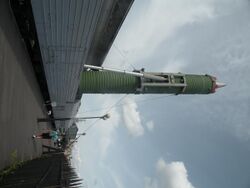Engineering:Railcar-launched ICBM
A railcar-launched ICBM is a train that is equipped with the capability to launch intercontinental ballistic missiles. The most well known example, and the first to reach operational status, is the Soviet RT-23 Molodets. The United States planned and started development of an analogue, the Peacekeeper Rail Garrison, but abandoned the plan with the end of the Cold War. Similar systems were tested by China in 2016 and North Korea in 2021.
Background
ICBMs are large, and not easily mobile. For this reason, they are traditionally launched from fixed missile silos. However, keeping missiles in fixed positions leaves them vulnerable to a potential pre-emptive nuclear strike.[1] For the purposes of strategic deterrence, nuclear armed nations seek to ensure mutually assured destruction, meaning that even if one nation launches a nuclear first strike on the other, that nation would still be able to launch a retaliatory nuclear strike of its own.[2]
Advantages
Rail-mobile ICBM systems are significantly harder to destroy than fixed positions, as they can travel anywhere along a nation's rail network, and hide from satellite surveillance in tunnels.[1][3] During times of heightened international tensions, railroad based ICBMs can be rapidly mobilized and spread out across a country's railroad network as an insurance policy.[3]
Disadvantages
Railroad based ICBMs also have several drawbacks. While basing them on railroad tracks makes them flexible, they are still limited by where railroad tracks exist.[2] Railroad tracks are also vulnerable to sabotage, which would be a major concern during times of war.[2] It is also difficult to maintain security along vast railroad networks, even during peacetime.[2]
Examples
RT-23 Molodets
The USSR was the first nation to develop an ICBM system that was mobile by rail. Named the RT-23 Molodets, the system was deployed on specially designed trains in the 1980s on the Soviet rail network.[2]
Peacekeeper Rail Garrison
In the 1980s, military planners in the United States conceived the Peacekeeper Rail Garrison as a means of pairing LGM-118 Peacekeeper missiles with the mobility of a train. The missiles would be disguised as normal boxcars and carried on dedicated trains operated by the United States Air Force , with an initial inventory of 25 trains, each carrying two Peacekeepers.[4]
In a 1988 article in Air Force Magazine , a defense analyst described the benefits of a rail based ICBM system:
"Peacekeeper ICBMs mounted on railway cars can also disperse beyond the limits of the Soviet ICBM threat if given any kind of warning time. Within three hours after dispersal has begun, the attack price to the USSR for destroying the Peacekeeper rail-mobile force would exceed the entire projected SS-18 warhead inventory. Trying to target US mobile ICBM forces as they dispersed—along with other triad elements and fixed US targets—would be a targeting nightmare for Soviet warplanners."[3]
The Cold War came to an end while the system was still in development, and as a result the program was cancelled to reduce costs, with one prototype Peacekeeper Rail Garrison car preserved at the National Museum of the United States Air Force.[4]
Chinese system
China performed a cold launch test of a railroad based ICBM system in December 2016, which is equipped with the country's DF-41 missile and operated by the People's Liberation Army Rocket Force.[5]
North Korean system
In September 2021, North Korea tested a new rail-based ICBM system, and released photos of it firing a missile.[1] A North Korean official said of the system, "The railway-borne missile system serves as an efficient counter-strike means capable of dealing a harsh multi-concurrent blow to the threat-posing forces."[6] The country has stated it plans to create a brigade of railroad based ICBM launchers in the near future.[6]
References
- ↑ 1.0 1.1 1.2 "It’s the Launcher, Not the Missile: Initial Evaluation of North Korea’s Rail-Mobile Missile Launches - 38 North: Informed Analysis of North Korea" (in en). 2021-09-17. https://www.38north.org/2021/09/its-the-launcher-not-the-missile-initial-evaluation-of-north-koreas-rail-mobile-missile-launches/.
- ↑ 2.0 2.1 2.2 2.3 2.4 Mizokami, Kyle (2017-02-27). "All Aboard Russia's Nuclear Weapon Apocalypse Train" (in en-US). https://www.popularmechanics.com/military/weapons/a25423/all-aboard-russias-apocalypse-train/.
- ↑ 3.0 3.1 3.2 Schneider, Barry R. (February 1, 1988). "The Case for Mobile ICBMs" (in en-US). https://www.airforcemag.com/article/0288sicbm/.
- ↑ 4.0 4.1 "Peacekeeper Rail Garrison Car" (in en-US). http://www.nationalmuseum.af.mil/Visit/Museum-Exhibits/Fact-Sheets/Display/Article/197554/peacekeeper-rail-garrison-car/.
- ↑ Gady, Franz-Stefan. "China Tests New Rail-Mobile Missile Capable of Hitting all of US" (in en-US). https://thediplomat.com/2016/01/china-tests-new-rail-mobile-missile-capable-of-hitting-all-of-us/.
- ↑ 6.0 6.1 Smith, Josh (2021-09-16). "N.Korea says it tested new railway-borne missile system to strike 'threatening forces'" (in en). Reuters. https://www.reuters.com/world/asia-pacific/nkorea-launches-were-test-new-railway-borne-missile-system-kcna-2021-09-15/.



